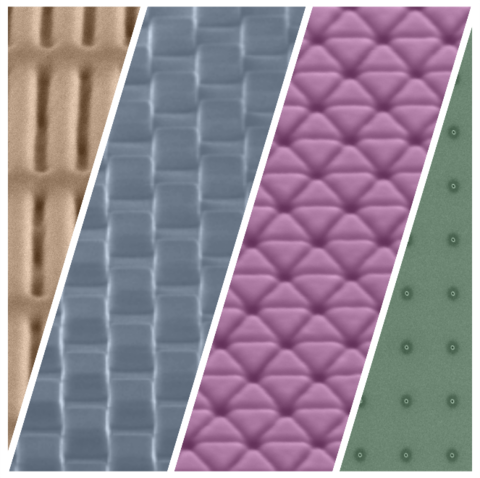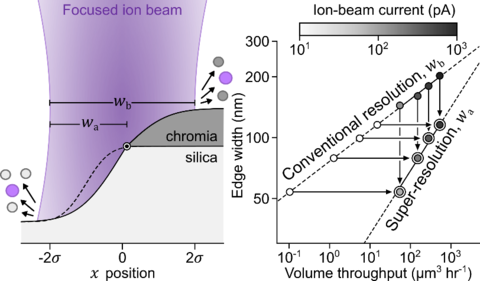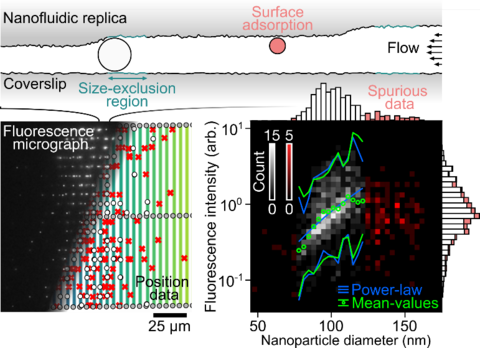Summary
Focused-ion-beam machining is a powerful method to directly form complex nanostructures. The Nanostructure Fabrication and Measurement Group develops novel processes to improve patterning resolution and throughput and applies these processes to fabricate device technologies and microscopy standards that yield new measurement capabilities.
Description

Focused-ion-beam machining of: (left) Subwavelength slits in crystalline gold for guiding light; (center left) a three-dimensional step height standard in silica; (center right) an array of plasmonic antennas in gold for confining of light; (right) an array of apertures in platinum for optical microscope calibration.
Structure determines function in diverse nanotechnologies, so that making devices to control or measure nanoscale phenomena begins with control of nanoscale structure. Few fabrication systems outperform the focused ion beam to pattern nanostructures by directing ions of various elements to an intense spot ranging in diameter down to a few nanometers. As these ions bombard a sample, they interact energetically with the substrate. Focused-ion-beam systems typically include a scanning electron microscope in a configuration where lenses for both ions and electrons enable precise machining through sputtering, milling, or deposition processes and structural metrology through scanning electron microscopy and X-ray analysis. This convergence yields a powerful tool to make and measure nanostructures, and we continue to advance both the fundamental science of focused-ion-beam machining and the devices and measurements that such science enables.
We are advancing the limits of focused-ion-beam machining, exploring advantageous material responses, pushing critical dimensions to smaller scales, and increasing throughput to facilitate manufacturing. Our work extends to developing novel processes, such as using a sacrificial film to mask the spatial extent of the ion beam, super-resolving the edge widths of nanostructures and enabling dramatic improvements to volume throughput. Motivating this fundamental research of nanofabrication, the Division has applied focused-ion-beam machining to pattern metallic substrates that support plasmons to produce structural color or to guide, confine, or manipulate light and electrons. We have also combined focused-ion-beam machining of dielectric materials with pattern replication by soft lithography to efficiently fabricate nanofluidic devices that automate dimensional and optical metrology of colloidal nanoparticles with record precision, accuracy, and throughput. Ongoing work aims to apply the focused ion beam to machine three-dimensional standards for super-resolution optical microscopy. These optical devices combine complex topography, accurate to several nanometers and ranging in depth over several micrometers, with nanoscale apertures to enable lateral and axial calibration of optical microscopes. Such a calibration will enable rapid measurements that will feed back to the design and fabrication of future photonic and fluidic devices, exemplifying the virtuous cycle of fabrication and measurement, which is at the core of the mission of the Division.
Highlights

Highlight: Super-resolution and ultrahigh-throughput of a focused-ion-beam
Focused-ion-beam machining enables the direct formation of complex devices, but is generally too slow and costly for profitable manufacturing. We recently advanced an emerging process of spatial masking to overcome conventional limits of lateral resolution and volume throughput, both of which are set by the current of the ion beam. In this approach, a sacrificial film masks a working material from the diffuse periphery, or tail, of the focused ion beam, effectively reducing the beam radius and super-resolving the edge widths of resulting nanostructures. Surprisingly, we found that machining in the presence of a sacrificial film yields an unconventional volume throughput that surpasses the conventional volume throughput by orders of magnitude, demonstrating a decisive temporal advantage that enables a paradigm shift from prototyping to manufacturing.
- Madison, A. C., et al. Unmasking the Resolution–Throughput Tradespace of Focused-Ion-Beam Machining, Advanced Functional Materials (2022)

Highlight: Nanofluidic replicas for nanoparticle characterization
The Division has applied focused-ion-beam machining to form nanofluidic devices that upgrade an ordinary optical microscope into an extraordinary metrology system for colloidal nanoparticles. We have machined silica masters in the form of a staircase, with steps that differ in depth by a few nanometers, and fiducials that build reference positions into the device. Replication of the devices by soft lithography, which amortizes fabrication costs, transfers critical dimensions from hard materials to polymeric replicas, quantifying subnanometer effects of pattern transfer on roughness and depth. In a novel analogue of a lateral flow assay, a nanoparticle suspension fills the disposable replica by capillarity, driving nanoparticles into positions of size exclusion where step edges prevent further transport. Optical microscopy and statistical modeling discriminate size exclusion from surface adsorption, accurately referring nanoparticle positions to device depths to yield nanoparticle diameters. Applying this system to polystyrene nanoparticles, which sorb and carry fluorophores, we quantified a known size distribution with nanometer accuracy and revealed surprising heterogeneity of fluorescence intensity. This study elucidates the fundamental structure–property relationship of unofficial standards for fluorescence microscopy and model nanoplastics as sorbents and carriers of toxic chemicals, resetting expectations for basic concepts of sorption and common practices of ensemble analysis.
- Liao, K.-T., et al. Subnanometer structure and function from ion beams through complex fluidics to fluorescent particles. Lab on a Chip 18 (2018)
- Liao, K.-T., et al. Nanoplastic fluorescence heterogeneity, arXiv 2101.03881 (2020)

